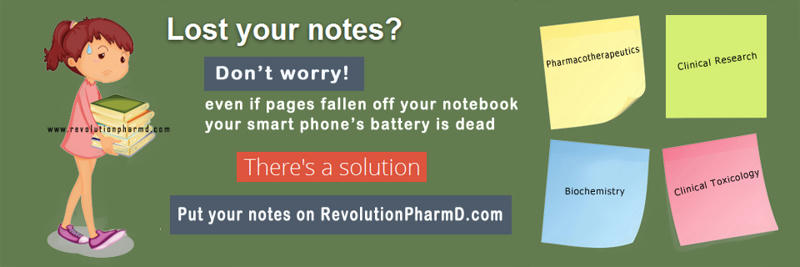Pharm.D. passed out students are well suited to the growing needs of Health care system in our country.
a) The Pharm.D. curriculum
features an integrated approach to delivery across disciplines and training in
essential professional and generic skills and attitudes that are embedded and
holistically assessed through an innovative approach to teaching and learning.
Graduates will be optimally equipped to deliver first rate pharmaceutical and
healthcare to the society.
Pharmacy Practice Regulation planned, clinical pharmacy mandatory in hospitals.
The government under the direction of Pharmacy Council of India (PCI) is in the process of finalizing the same. Details on the time-frame for implementation are not available. But experts opine that this move would have a positive impact for pharmacy education in India
Moreover, US and UK governments now recognize only Pharm D as a minimum entry qualification for jobs. The hospitals in the Middle East prefer Pharm D over B Pharm degree holders. In India too, once the Regulation is enforced, the government will insist on Pharm D as the basic degree for candidates to work at the departments of clinical pharmacy in hospitals.
PCI draft guidelines seek legal framework for pharmacists
PCI has also suggested a cap on the number of seats offered by pharmacy colleges to improve quality of education.
Mumbai: The Pharmacy Council of India (PCI) has proposed that
pharmacists should be recognized as practising professionals with legal
obligations not only to patients, but also to physicians and other
healthcare workers.
“Medicines are being misused and the number of
drug-induced diseases is increasing. So, we are looking to legally bind
pharmacists (who are mostly employed in chemist shops) in delivering
certain outcomes and emphasizing their competencies very clearly,” said
B. Suresh, president of PCI, which last week submitted draft guidelines
to the health ministry to this effect.
Otitis Media
Yvette C. Terrie, BSPharm, RPh
Informed counseling can help
patients and caregivers identify, treat, and prevent painful ear infections.
Otitis Media:
Otitis media is an infection of the middle ear and can be further classified into 3 forms according to symptoms and degrees of severity. These include acute otitis media (AOM), otitis media with effusion (OME), and chronic suppurative otitis media (CSOM).
Acute Otitis Media
AOM is defined by the American Academy of Pediatrics (AAP) and the American Academy of Family Physicians (AAFP) as an infection of the middle ear with acute onset, presence of middle ear effusion (MEE), and signs of middle ear inflammation.1 AOM is considered to be the most frequent diagnosis among patients in the pediatric population, second only to the common cold.1,2 Although AOM can affect patients of all ages, it primarily affects infants and young children with a peak incidence age between 6 and 36 months.2 An estimated two thirds of all children in the United States experience at least 1 episode of AOM prior to the age of 1 year, and an estimated 80% have had at least 1 case of AOM by the age of 3 years.1,3 There is a second peak incidence of AOM cases around the age of 5 years that is believed to be associated with entrance into school.4
AOM is also considered to be the most prevalent reason for physician office visits within the pediatric patient population.5 Annually, an estimated 20 million office visits are attributed to AOM, and this does not include visits to the emergency department.5 Statistics report that in the United States, AOM is the most common reason for outpatient antimicrobial treatment among the pediatric patient population. 4,6 During the mid-1990s, treatment of otitis media cost $3.8 billion annually; 20% of the more than 110 million prescriptions for oral antibiotics were prescribed for this condition.4,5
In 2006, statistics reveal that an estimated 9 million children, ranging in age from 0 to 17 years, were reported to have an episode of AOM.1 Of those children, 8 million visited a physician or obtained a prescription drug to diagnose and treat the condition.1 Although AOM primarily affects the pediatric population, adults make up less than 20% of patients presenting with AOM.6 Table 1 defines the 3 types of otitis media.5,7-9
Pathophysiology
The etiology of AOM may be viral or bacterial. 9, 10 Viral infections are often complicated by a secondary bacterial infection.10 Streptococcus pneumoniae, Haemophilus influenzae, Moraxella catarrhalis, and Streptococcus pyogenes are responsible for the majority of AOM cases in patients older than 6 weeks.3 S pneumoniae is the most common pathogen responsible for AOM and for invasive bacterial infections in children of all age groups.3 Other bacteria recovered and responsible in cases of AOM include Staphylococcus aureus, Streptococcus viridans, and Pseudomonas aeruginosa.3,5,10
AOM typically manifests itself as a complication of a preceding upper respiratory tract infection.1,2,11 The secretions and inflammation cause a relative obstruction of the Eustachian tubes and the middle ear mucosa absorbs air in the middle ear under normal circumstances. If the air is not replaced because of obstruction of the Eustachian tube, a negative pressure is generated, which results in interstitial fluid entering the Eustachian tube and creating an effusion.1-3 This effusion of the middle ear provides an excellent medium for microbial growth and, if growth is rapid, a middle ear infection develops.1,2
Risk Factors for Otitis Media
Various factors may increase an individual’s risk for developing AOM and, in general, these factors may be classified as patient related or environmental.1,4,5 Examples of proven risk factors for otitis media include:1,4,5
Patient Factors
• Premature or low birth weight
• Young age
• Early onset of ear infections
• Familial history
• Native American, Inuit, and Australian Aborigine populations appear to have a greater incidence
• Compromised immune system
• Craniofacial abnormalities
• Neuromuscular disease
• History of allergies and/or upper respiratory tract infections
Environmental Factors
• Day care attendance
• Crowded living conditions
• Exposure to tobacco and other pollutants
• Pacifier use
• Bottlefeeding increases risk compared with breastfeeding
• Prolonged bottle use
• Fall and winter months
Signs and Symptoms
The signs and symptoms commonly associated with AOM include fever, otalgia, headache, irritability, cough, rhinitis, listlessness, vomiting, diarrhea, and pulling at the ears.1-3,9-11
Infants may appear cranky, have difficulty sleeping, and pull at the affected ear(s). Compared with children, adults more often present with otalgia, ear drainage, diminished hearing, and sore throat.10 Opacity and redness of the tympanic membrane are equally common in children and adults.1-4,10
Treatment
The AAP and the AAFP published updated guidelines in 2004 for the management and treatment of AOM, which addressed pain management, initial observation versus treatment with antibiotics, and appropriate choices of antibiotics. 10,12 According to these guidelines, the “observation option” for AOM refers to deferring antibiotic treatment for healthy children aged 6 months to 2 years with nonsevere illness and an uncertain diagnosis, as well as for patients older than 2 years of age for 48 to 72 hours and limiting management to symptomatic relief.12 The decision to observe or treat is based on the child’s age, diagnostic certainty, and illness severity.12 For patients under observation without initial antibiotic therapy, it is imperative that the parent/ caregiver communicate with the health care professional regarding the patient’s condition to prevent any further complications and report if the symptoms appear to worsen.12
The guidelines stressed the importance of an accurate diagnosis to rule out OME, which often is present before and after AOM and is not treated with antibiotics. 4,10,12
Antibiotics are recommended in all patients younger than 6 months of age, in those between 6 months and 2 years, if the diagnosis is certain, and in children with severe infection.10,12 The recommended first-line therapy is a dosage of 80 to 90 mg per kg/day of amoxicillin. Alternatives for those who are sensitive or allergic to penicillin and with resistant infections include the macrolide antibiotics, clindamycin, and cephalosporins.10,12 Patients who do not respond to treatment should be reassessed.10,12
Since pain is often present especially during the first 24 hours of AOM cases, the AAP and AAFP recommend that pain management be addressed regardless of the use of antibiotics.12 Pain treatment options include acetaminophen, ibuprofen, and otic drops such as antipyrine/ benzocaine otic solution.1,12 Prior to use, patients should be screened for possible allergies, drug%u2500drug interactions, and contraindications.
Preventive Measures
When counseling the parents and caregivers of patients with AOM, pharmacists can provide key information for reducing or preventing the incidence of AOM. Examples of these preventive measures include:1,7
• If appropriate, vaccinate children against the flu annually.
• Vaccinate the child with the 7-valent pneumococcal conjugate (PCV7) vaccine. Studies show that this vaccine protects against a number of the most common bacteria that cause ear infections and is indicated for the prevention of otitis media (ear infection) caused by 7 strains of S pneumoniae.1,7,12-14 The Centers for Disease Control and Prevention recommends that all children under age 2 years be vaccinated, starting at 2 months.1, 7, 13 Results from various studies have shown that vaccinated children get fewer ear infections than children who were not vaccinated. The PCV7 vaccine is strongly recommended for children in day care.1,7
• Practice routine hand-washing techniques to prevent the transmission of germs to keep children healthy.
• Avoid exposing children to cigarette smoke fumes. Studies have shown that infants who are around smokers have more ear infections.
• Never put an infant down for a nap, or for the night, with a bottle. PT
Otitis media is an infection of the middle ear and can be further classified into 3 forms according to symptoms and degrees of severity. These include acute otitis media (AOM), otitis media with effusion (OME), and chronic suppurative otitis media (CSOM).
Acute Otitis Media
AOM is defined by the American Academy of Pediatrics (AAP) and the American Academy of Family Physicians (AAFP) as an infection of the middle ear with acute onset, presence of middle ear effusion (MEE), and signs of middle ear inflammation.1 AOM is considered to be the most frequent diagnosis among patients in the pediatric population, second only to the common cold.1,2 Although AOM can affect patients of all ages, it primarily affects infants and young children with a peak incidence age between 6 and 36 months.2 An estimated two thirds of all children in the United States experience at least 1 episode of AOM prior to the age of 1 year, and an estimated 80% have had at least 1 case of AOM by the age of 3 years.1,3 There is a second peak incidence of AOM cases around the age of 5 years that is believed to be associated with entrance into school.4
AOM is also considered to be the most prevalent reason for physician office visits within the pediatric patient population.5 Annually, an estimated 20 million office visits are attributed to AOM, and this does not include visits to the emergency department.5 Statistics report that in the United States, AOM is the most common reason for outpatient antimicrobial treatment among the pediatric patient population. 4,6 During the mid-1990s, treatment of otitis media cost $3.8 billion annually; 20% of the more than 110 million prescriptions for oral antibiotics were prescribed for this condition.4,5
In 2006, statistics reveal that an estimated 9 million children, ranging in age from 0 to 17 years, were reported to have an episode of AOM.1 Of those children, 8 million visited a physician or obtained a prescription drug to diagnose and treat the condition.1 Although AOM primarily affects the pediatric population, adults make up less than 20% of patients presenting with AOM.6 Table 1 defines the 3 types of otitis media.5,7-9
Pathophysiology
The etiology of AOM may be viral or bacterial. 9, 10 Viral infections are often complicated by a secondary bacterial infection.10 Streptococcus pneumoniae, Haemophilus influenzae, Moraxella catarrhalis, and Streptococcus pyogenes are responsible for the majority of AOM cases in patients older than 6 weeks.3 S pneumoniae is the most common pathogen responsible for AOM and for invasive bacterial infections in children of all age groups.3 Other bacteria recovered and responsible in cases of AOM include Staphylococcus aureus, Streptococcus viridans, and Pseudomonas aeruginosa.3,5,10
AOM typically manifests itself as a complication of a preceding upper respiratory tract infection.1,2,11 The secretions and inflammation cause a relative obstruction of the Eustachian tubes and the middle ear mucosa absorbs air in the middle ear under normal circumstances. If the air is not replaced because of obstruction of the Eustachian tube, a negative pressure is generated, which results in interstitial fluid entering the Eustachian tube and creating an effusion.1-3 This effusion of the middle ear provides an excellent medium for microbial growth and, if growth is rapid, a middle ear infection develops.1,2
Risk Factors for Otitis Media
Various factors may increase an individual’s risk for developing AOM and, in general, these factors may be classified as patient related or environmental.1,4,5 Examples of proven risk factors for otitis media include:1,4,5
Patient Factors
• Premature or low birth weight
• Young age
• Early onset of ear infections
• Familial history
• Native American, Inuit, and Australian Aborigine populations appear to have a greater incidence
• Compromised immune system
• Craniofacial abnormalities
• Neuromuscular disease
• History of allergies and/or upper respiratory tract infections
Environmental Factors
• Day care attendance
• Crowded living conditions
• Exposure to tobacco and other pollutants
• Pacifier use
• Bottlefeeding increases risk compared with breastfeeding
• Prolonged bottle use
• Fall and winter months
Signs and Symptoms
The signs and symptoms commonly associated with AOM include fever, otalgia, headache, irritability, cough, rhinitis, listlessness, vomiting, diarrhea, and pulling at the ears.1-3,9-11
Infants may appear cranky, have difficulty sleeping, and pull at the affected ear(s). Compared with children, adults more often present with otalgia, ear drainage, diminished hearing, and sore throat.10 Opacity and redness of the tympanic membrane are equally common in children and adults.1-4,10
Treatment
The AAP and the AAFP published updated guidelines in 2004 for the management and treatment of AOM, which addressed pain management, initial observation versus treatment with antibiotics, and appropriate choices of antibiotics. 10,12 According to these guidelines, the “observation option” for AOM refers to deferring antibiotic treatment for healthy children aged 6 months to 2 years with nonsevere illness and an uncertain diagnosis, as well as for patients older than 2 years of age for 48 to 72 hours and limiting management to symptomatic relief.12 The decision to observe or treat is based on the child’s age, diagnostic certainty, and illness severity.12 For patients under observation without initial antibiotic therapy, it is imperative that the parent/ caregiver communicate with the health care professional regarding the patient’s condition to prevent any further complications and report if the symptoms appear to worsen.12
The guidelines stressed the importance of an accurate diagnosis to rule out OME, which often is present before and after AOM and is not treated with antibiotics. 4,10,12
Antibiotics are recommended in all patients younger than 6 months of age, in those between 6 months and 2 years, if the diagnosis is certain, and in children with severe infection.10,12 The recommended first-line therapy is a dosage of 80 to 90 mg per kg/day of amoxicillin. Alternatives for those who are sensitive or allergic to penicillin and with resistant infections include the macrolide antibiotics, clindamycin, and cephalosporins.10,12 Patients who do not respond to treatment should be reassessed.10,12
Since pain is often present especially during the first 24 hours of AOM cases, the AAP and AAFP recommend that pain management be addressed regardless of the use of antibiotics.12 Pain treatment options include acetaminophen, ibuprofen, and otic drops such as antipyrine/ benzocaine otic solution.1,12 Prior to use, patients should be screened for possible allergies, drug%u2500drug interactions, and contraindications.
Preventive Measures
When counseling the parents and caregivers of patients with AOM, pharmacists can provide key information for reducing or preventing the incidence of AOM. Examples of these preventive measures include:1,7
• If appropriate, vaccinate children against the flu annually.
• Vaccinate the child with the 7-valent pneumococcal conjugate (PCV7) vaccine. Studies show that this vaccine protects against a number of the most common bacteria that cause ear infections and is indicated for the prevention of otitis media (ear infection) caused by 7 strains of S pneumoniae.1,7,12-14 The Centers for Disease Control and Prevention recommends that all children under age 2 years be vaccinated, starting at 2 months.1, 7, 13 Results from various studies have shown that vaccinated children get fewer ear infections than children who were not vaccinated. The PCV7 vaccine is strongly recommended for children in day care.1,7
• Practice routine hand-washing techniques to prevent the transmission of germs to keep children healthy.
• Avoid exposing children to cigarette smoke fumes. Studies have shown that infants who are around smokers have more ear infections.
• Never put an infant down for a nap, or for the night, with a bottle. PT
Consideration of colonoscopy
Colonoscopy is a procedure that examines the colon by inserting a
tube through the rectum person or colonoscopy. Medical procedures by
doctors for patients with adenomas and the growth of polyps in the
colon, which is said to eventually lead to cause cancer if not treated.
Classification Of Food Poisoning
I. Based on symptoms and duration of onset:
a. Nausea and vomiting within six hours (Staphylococcus aureus, Bacillus cereus)
b. Abdominal cramps and diarrhoea within 8-16 hours (Clostridium perfringens, Bacillus cereus)
c. Fever, abdominal cramps and diarrhoea within 16-48 hours (Salmonella, Shigella, Vibrio
parahemolyticus, Enteroinvasive E.coli, Campylobacter jejuni)
d. Abdominal cramps and watery diarrhoea within 16-72 hours (Enterotoxigenic E.coli, Vibrio cholerae
O1, O139, Vibrio parahemolyticus, NAG vibrios, Norwalk virus)
e. Fever and abdominal cramps within 16-48 hours (Yersinia enterocolitica)
f. Bloody diarrhoea without fever within 72-120 hours (Enterohemorrhagic E.coli O157:H7)
g. Nausea, vomiting, diarrhoea and paralysis within 18-36 hours (Clostridium botulinum)
a. Nausea and vomiting within six hours (Staphylococcus aureus, Bacillus cereus)
b. Abdominal cramps and diarrhoea within 8-16 hours (Clostridium perfringens, Bacillus cereus)
c. Fever, abdominal cramps and diarrhoea within 16-48 hours (Salmonella, Shigella, Vibrio
parahemolyticus, Enteroinvasive E.coli, Campylobacter jejuni)
d. Abdominal cramps and watery diarrhoea within 16-72 hours (Enterotoxigenic E.coli, Vibrio cholerae
O1, O139, Vibrio parahemolyticus, NAG vibrios, Norwalk virus)
e. Fever and abdominal cramps within 16-48 hours (Yersinia enterocolitica)
f. Bloody diarrhoea without fever within 72-120 hours (Enterohemorrhagic E.coli O157:H7)
g. Nausea, vomiting, diarrhoea and paralysis within 18-36 hours (Clostridium botulinum)
Duties of the clinical pharmacist
You might observe that change is almost
universal among different countries and is related to developments in medical
technology, health economics, informatics, socio-economic status, and
professional relations. This is due to the rapid changes in the development if
the health care fields to develop disease free environment and to carry the
healthy atmosphere.
Increasing copying of review/research articles among Indian Pharmacy Students
In India more and more
professionals, specially students of mainly UG and PG level are interested in
publishing review or research article in their name either due to personal
interest or by pressure from the institutional guide.This situation of increasing
awareness of publishing the original work is definitely a great boon to Indian
research scenario, but the underlying fraud of doing plagiarism is lowering the
worthiness of Indian research work, we are losing our credibility and the same
can be seen in the increasing cases of rejected articles from Indian authors
who conducted research work in less known institutes in India.
Its not
only students that are responsible for this fraud work, but also the
faculty,university, journals editors and reviewers,publishers etc. all in some
way a part of this.
we surely need to have some concrete measures taken to stop this cheating process.The irnoy is that most of the persons doing this dont even have any knowledge that its not a good practice. Indian Universities and regulatory bodies concerning this should take plagiarism seriously.Awareness should be generated among the students as they mostly dont even know what they are doing.
we surely need to have some concrete measures taken to stop this cheating process.The irnoy is that most of the persons doing this dont even have any knowledge that its not a good practice. Indian Universities and regulatory bodies concerning this should take plagiarism seriously.Awareness should be generated among the students as they mostly dont even know what they are doing.
Please come and share your views on how this plagiarism is
increasing,factors responsible and more importantly how it can be eradicated
REFERENCE: http://en.wikipedia.org/wiki/Academic_dishonesty)
- Sai
kumar Katam,PharmD.
IPA recommends setting up of pharmaceutical wing in Indian Military
The hospital pharmacy division of the Indian Pharmaceutical Association
(IPA) has urged the Union Ministry of Defence to establish a Hospital
Pharmacy Services or ‘Pharmacy Corps’ in the 127 defense hospitals in
the country.
In a memorandum to the union defence minister, A K
Antony, the IPA said for better patient care and rational use of drugs
among defence personnel, the services of a separate sect of Pharmacy
Corps are inevitable. The missive to the minister also requested the
minister to consider the National Human Rights Commission report of 1999
and the Hathi Committee report of 1975 while implementing the drugs
dispensing wing in the defense sector.
Subscribe to:
Posts (Atom)








